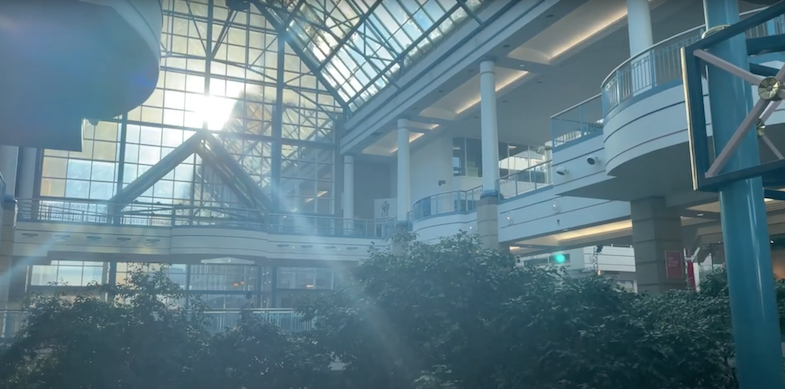
By Owen Toews
Previously published in the Winnipeg Free Press March 3, 2022
The clamour around the future of Portage Place has quieted down to a chirp, for the moment, closer to the timbre of the sparrows that live in the mall than to the bluster of Bay Street billionaires. The stage is now set for a more modest yet in many ways profoundly more ambitious vision for the neighbourhood mall than the one formerly proposed by Toronto mega-developer Starlight Acquisitions.
A welcome, unintended effect of the Forks North Portage Partnership’s proposed – and now terminated – sale of Portage Place to Starlight was that it prompted community leaders who opposed the sale to sketch the broad outlines of a grassroots vision for Portage Place, based on priorities that radically differ from those of large property owners and business-oriented politicians. Inner-city community leaders now agree that the counter vision for Portage Place that they have spent the past several years articulating makes an open-ended community consultation about the mall’s future unnecessary. The community-based vision for Portage Place – as formulated by community leaders who made presentations at City Hall and formed the Portage Place Community Coalition and Portage Place Community Voices Committee – is made up of four key pillars:
1.Portage Place should become a non-profit community centre (that may include for-profit stores offering affordable necessities, as determined by the community) primarily for the people in the neighbourhood, rather than a corporate shopping mall aspiring to serve Jets ticketholders.
2. Hundreds of new rent-geared-to-income social housing units should be built at Portage Place.
3. A real safety plan that centres Indigenous women and girls should replace the current security approach.
4. Indigenous peoples should own Portage Place.
How possible is this? Since 2019, three things have transpired that make a community-based Portage Place appear realistic.
First, the federal government, which owns the land and parking garage beneath Portage Place jointly with the City and Province, has acknowledged it must consider its treaty obligations before privatizing its Portage Place assets. This means that a Treaty Land Entitlement process, like the one that led to the Treaty One Development Corporation’s Naawi-Oodena redevelopment of the Kapyong Barracks, could be a possibility for Portage Place.
Second, the City and Province have shown their hand by offering a combined $49 million for the redevelopment of Portage Place, to Starlight. What is more, the federal government did not reject out of hand Starlight’s request for $50 million plus $240 million in loans. While the City and Province’s commitments were made with the aim of attracting investment and increasing the tax base, those levels of government have a responsibility to fund community centres and social housing. Given that the building was offered for sale by Vancouver-based Peterson Group, before the pandemic, for only $23 million, a public purchase of Portage Place would seem to be easily accomplished.
Third, the Hudson’s Bay Company’s downtown Winnipeg department store, which permanently closed in 2020 and is valued at $0, is attached to Portage Place by a skywalk. Given that the bulk of the Hudson’s Bay Company’s wealth was stolen from Indigenous peoples by means of exploitative terms of trade and a 7 million acre land grant from the British Empire made without the involvement of Indigenous peoples, the immense level of unmet need that exists in Winnipeg’s city centre, and the stated willingness of the City and Province to support its redevelopment, the Bay building would make a logical component – and the Hudson’s Bay Company would make a logical funder – of an Indigenous-owned Portage Place-Bay building community centre and housing complex.
The profit rates of enclosed shopping malls around the world are declining and a worldwide process of “demalling” is taking place, with cities from Lisbon to Memphis turning disinvested malls into human services centres. Winnipeg community leaders have a demonstrated capacity to transform large, outmoded buildings into thriving new community infrastructure, with a long track record of inspiring examples that includes the redevelopment of the Canadian Pacific Railway depot on Higgins Avenue into the Neeginan Centre, the Gault building on Arthur Street into Artspace, the Christie’s Biscuits factory on Notre Dame Street into the Specialized Services for Children and Youth centre, and, as we speak, Kapyong Barracks into Naawi-Oodena.
What is needed now is a formal counter proposal, based on the four pillars above, for communities and organizations to rally around. As the powers that be quietly scramble to find another developer to gentrify the mall, the door has opened for community leaders to seize the public conversation.
Owen Toews is the author of “What’s Going on With Portage Place?”, recently published report by the Canadian Centre for Policy Alternatives in Placing Community at the Heart of Recovery from COVID: The State of the Inner City Report 2022 available at www.policyalternatives.ca/manitoba.


